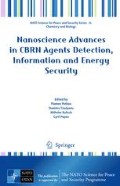Abstract
The present volume comprises the most important contributions to the NATO ASI “Nanoscience advances in CBRN agent detection, information and energy security” held on 29.5.–6.6.2014 in Sozopol, Bulgaria. This short introduction aims to give an overview of the topics of the ASI and to relate them to the presently actual state of the art, but also to future fields of research in nanosciences and nanotechnology. Another aim of this introduction is to hint the reader to the most important contributions of these proceedings. Although nanotechnological products can presently be found in a wide range of application fields, in the ASI the topics were restricted to a number of fields which are related to the future well-being and safety of planet earth. This may sound exaggerated but the future of our planet will indeed rely on the ability to detect dangerous agents (chemical, biological and radionuclear = CBRN) as well as to provide a clean environment, health, and energy and information safety. With other words: The topics of this ASI are at the leading edge to solve many of the currently most important questions to be tackled by science and technology.
Access this chapter
Tax calculation will be finalised at checkout
Purchases are for personal use only
Notes
- 1.
The paper of Paunović et al. on page 239 provides some insight into the differences between top-down and bottom-up approaches.
- 2.
This question is to some extent addressed in the contribution of Vasileiadis and Yannopoulos on page 17.
- 3.
An example can be found in the paper of Meinl et al. on page 29.
- 4.
The preparation of nanostructures by ion implantation is discussed in detail in the contribution of Kavetskyy and Stepanov on page 35.
- 5.
See, for example, the paper of Harea et al. on page 53.
- 6.
Blue light emitting diamond nanostructures are discussed in the contribution of Himics et al. on page 93.
- 7.
The article of K. Govatsi, A. Chrissanthopoulos, and S.N. Yannopoulos on page 129 gives a good overview about the growth and properties of ZnO nanowires.
- 8.
The contribution of Kukhta on page 207 reports on the preparation and properties of organic–inorganic nanocomposites. The article of Telegeev et al. on page 185 addresses the properties of silver nanoparticles covered by methyl methacrylate oligomers.
- 9.
The paper of Costa on page 227 discusses the microwave electrical properties of nanocomposites.
- 10.
The structural, optical and electrical properties of nanostructured ZnO films are discussed in the paper of Lovchinov et al. on page 289.
- 11.
Harizanova et al. discuss the magnetic and dielectric properties of oxide-glass ceramics with nanosized crystals (page 359).
- 12.
See in this context the paper of Kharlamova et al. on page 461.
- 13.
The article of Tsiulianu and Moraru on page 389 addresses the gas sensing properties of nanocrystalline tellurium films.
- 14.
The paper of Tonchev et al. on page 347 reports on sensors for X-ray radiation.
- 15.
The article of V.V. Vasilieva, M. Alyakov, and M.D. Apostolova on page 423 addresses the possibility to use nanoparticles for protection against gamma radiation.
- 16.
Boycheva et al. discuss nanocrystalline zeolites for environmental protection in their article on page 443.
- 17.
The paper of Pehlivanova et al. on page 479 addresses the use of nanostructures for the conversion of sun energy into electrical energy by the line given by natural photosynthesis.
- 18.
The use of perovskite materials for solid oxide fuel cells is discussed in the contribution of Koleva et al. on page 487.
- 19.
The contribution of Popov et al. on page 519 provides an instructive overview on this exciting topic.
References
Gleiter H (2000) Acta Mater 48:1
Bonnell DA (2003) J Vac Sci Technol A 21:194
Kassing R, Kulisch W (2006) In: Kassing R, Petkov P, Kulisch W, Popov C (eds) Functional properties of nanostructured materials. Springer, Berlin, p 3
Zhang K, Jiang M, Chen D (2012) Prog Polym Sci 37:445
Urban AS, Luttich AA, Stefani FD, Feldmann J (2010) Nano Lett 11:4794
Rapp L, Ailuno J, Alloncle AP, Delaporte P (2011) Opt Express 19:21563
Xiao H (2012) Introduction to semiconductor manufacturing technology. SPIE Press, Bellingham
Meyer E, Jarvis SP, Spencer ND (2004) MRS Bull 29:443
Binnig G, Rohrer H (1982) Helv Phys Acta 55:726
Binnig G, Quate CF, Gerber C (1986) Phys Rev Lett 56:930
Kassing R, Oesterschulze E, Kulisch W (2003) Surf Coat Technol 169/170:237
Oliver WC, Pharr GM (2004) J Mater Res 19:3
Hell SW, Wichmann J (1994) Opt Lett 19:780
Betzig E, Patterson GH, Sougrat R, Lindwasser OW, Olensuych S, Bonifacino JS, Davidson MW, Lippincott-Schwartz J, Hess HF (2006) Nature 313:1642
Auffan M, Rose J, Bottero J-Y, Lowry GV, Jolivet JP, Wiesner MR (2009) Nat Nanotechnol 4:634
Krüger A (2010) Carbon materials and nanomaterials. Wiley-VCH, Weinheim
Kroto HW, Heath JR, O'Brien SC, Curl RF, Smalley RE (1985) Nature 318:162
Iijima S (1991) Nature 354:56
Castro Neto AH, Guinea F, Peres NMR, Novoselov KS, Geim AK (2009) Rev Mod Phys 81:109
Tran QH, Nguyen VQ, Le A-T (2013) Adv Nat Sci: Nanosci Nanotechnol 4:033001
Lüth H (2010) Solid surfaces, interfaces and thin films. Springer, Berlin
Grätzel M (2001) Nature 414:338
Childress L, Hanson R (2013) MRS Bull 38:134
Greentree AD, Fairchild BA, Hossain FM, Prawer S (2008) Mater Today 11:22
Author information
Authors and Affiliations
Corresponding author
Editor information
Editors and Affiliations
Rights and permissions
Copyright information
© 2015 Springer Science+Business Media Dordrecht
About this paper
Cite this paper
Petkov, P., Tsiulyanu, D., Popov, C., Kulisch, W. (2015). Nanoscience Advances in CBRN Agent Detection, Information and Energy Security: An Introduction. In: Petkov, P., Tsiulyanu, D., Kulisch, W., Popov, C. (eds) Nanoscience Advances in CBRN Agents Detection, Information and Energy Security. NATO Science for Peace and Security Series A: Chemistry and Biology. Springer, Dordrecht. https://doi.org/10.1007/978-94-017-9697-2_1
Download citation
DOI: https://doi.org/10.1007/978-94-017-9697-2_1
Published:
Publisher Name: Springer, Dordrecht
Print ISBN: 978-94-017-9696-5
Online ISBN: 978-94-017-9697-2
eBook Packages: Biomedical and Life SciencesBiomedical and Life Sciences (R0)

